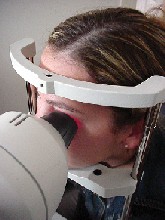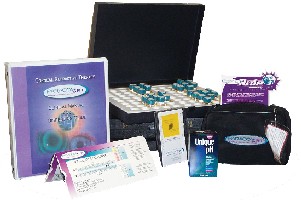After leaving a busy group practice to go solo, optometrist Shane Keddie, of Advanced Eyecare in Alberta, Canada, wanted to differentiate his practice from standard primary vision care. Initially, he was interested in comanaging LASIK and PRK patients. But, a low-cost, high-volume LASIK chain was starting to become an industry heavyweight in my area, and I saw a bleak financial future in refractive surgery comanagement, he says.

A corneal topographer can ease the process of fitting orthokeratology lenses.
Then Dr. Keddie read a paper discussing how a new overnight orthokeratology lens could correct up to 4.00D of myopia consistently in a short period. I was immediately hooked by a non-surgical alternative to LASIK that would retain patients and revenue in my practice, Dr. Keddie says.
The only problem was that only a small group of highly specialized doctors practiced orthokeratology, so there were no training courses available. After several phone calls, I was directed to one of the founders of the International Orthokeratology Society (IOS). Dr. Keddie spent a week in that doctors practice learning the basics. After attending several more ortho-K lectures, Dr. Keddie successfully began fitting patients with this modality.
While you may not have a long-standing interest in corneal reshaping with contact lenses, you can likely relate to Dr. Keddies experience with competition for LASIK patients. There are many ways to incorporate orthokeratology into your practice, and a variety of learning opportunities make it easier than ever to get training. Here, some of your colleagues share the secrets to their success with orthokeratology.
1. Know Your Stuff
Training is essential to your ability to fit corneal reshaping lenses and provide your patients with satisfactory correction. Some of you may find it easier than others. David Gubman, O.D., of Voorhees, N.J. and former Director for TLC Laser Eye Centers in Plymouth Meeting, Pa., found that orthokeratology was a natural extension of his interest in refractive surgery. There are many patients who desire freedom from traditional contact lenses, but are unwilling to accept either the cost or risk of elective eye surgery. This is precisely the niche filled by orthokeratology, he says.
Dr. Gubman began fitting orthokeratology lenses in 1991 during his cornea and specialty contact lens residency at the Pennsylvania College of Optometrys Eye Institute.
Both my residency training and years of practice have emphasized soft toric, gas permeable, toric and bifocal GPs, and keratoconic patient care as well as refractive surgery comanagement. In fact, I attend every refractive procedure performed on patients under my care, Dr. Gubman says. So, he was prepared to make orthokeratology a part of his practice.
Your colleagues can also be an excellent resource for learning about this aspect of contact lens care. Philadelphia optometrist Karen Wrigley always liked the concept of contact lenses worn only at night. She began by taking some continuing education classes at association meetings in 2000. Then, I spoke to a friend who was already doing it. He gave me the names of some experts in the field, and I picked their brains, she says. Because most of the necessary equipment is already part of an average practice, Dr. Wrigley was then ready to start fitting patients with overnight lenses.
2. Start Small
Dr. Wrigley offered her first few fits at a discounted fee. I explained that this was a new procedure and was able to get quite a few patients quickly, which gave me a lot of fitting experience fast, she says.
Another way to get started: Fit employees first. I offered the treatment to key staff as well as fitting myself. This helped address a lot of questions, as both my staff and I could answer with credibility, Dr. Keddie says.
San Diego optometrist Jerome Legerton, who worked with Paragon Vision Sciences to create the companys Corneal Refractive Therapy lens, agrees. That way, [staff] will have the experience of fitting, follow-up and what its like to sleep in a lens, he says.
Historically, ortho-K involves a series of lenses worn over a period of months to achieve a change in vision. Paragons CRT uses a single lens over a period of five to 14 days to correct myopia up to 6.00D.
Realize that the number of patients you fit will be related to the length of time it takes to fully incorporate orthokeratology. Jeffrey Walline, O.D., of Ohio State University College of Optometry, says be patient and work within your comfort level. If one person is fit every three to four weeks, it will take several months to become confident. If the first five patients are all scheduled on the same day and the staff and doctor continue to offer orthokeratology ... the learning curve is steep, and [it] will become routine within a couple of weeks, he says.
You might also start out with low myopes before trying to correct higher amounts of cylinder. Be cautious in your first year with [which patients] you choose to target and offer treatment, Dr. Keddie says, I would recommend patients who are 18 or older, with 1.25D to 2.50D of myopia.
3. Equip Your Practice
Much of the equipment you need for orthokeratology is already part of your practice, including a pho-ropter, slit lamp and fluorescein.
Opinions differ on whether a corneal topographer is essential for orthokeratology. Some O.D.s would not go without it. A corneal topographer is a critical tool for pre-corneal evaluation, including eccentricity values, as well as for follow-up and management, Dr. Gubman says.
Dr. Walline agrees. A corneal topographer is an absolute necessity for orthokeratology, he says. This will tell the clinician where the contact lens rests during sleep and helps to diagnose potential problems.
Dr. Legerton doesnt believe a topographer is absolutely necessary, but he thinks it is a worthwhile investment. Fitting one patient a month would more than pay for a topographer. If youre going to do it on a regular basis, topography will make it easier in the long run because it will tell you what the lens has been doing at night.
Dr. Legerton also suggests you keep an inventory of lenses in your dispensary rather than opt for one-time lens ordering. Otherwise, you might fit and order a lens, only to have it come in off-center. Dispen-sing lenses that dont center or are not proper is a waste of time. With a dispensing inventory, you can see with your own eyes what the lens looks like on the patient, he says.
4. Prep Your Staff

Marketing materials can help draw patients attention to the new service your practice offers.
Staff preparation is an integral part of adding this modality to your office. Dr. Gubmans staff was already accustomed to refractive surgery procedures, so it did not take them as long to learn about orthokeratology. I have not needed extensive restructuring of my practice or staff because orthokeratology fits nicely along the spectrum of refractive options between contact lenses and refractive surgery, he says.
However, Dr. Wrigleys employees needed several months to learn about the procedure. Some staff thought it permanently corrected vision and they were telling patients that in the beginning until I found out and retrained them, she says.
The same was true in Dr. Keddies office. I would say that it was a good year before our systems were running smoothly and questions were being answered thoroughly and effectively, he says.
5. Educate Patients
An educated staff also can help your patients learn about orthokeratology and the requirements for this kind of treatment. This is made easier by having an educated staff. Buttons, counter cards and other marketing materials can help build interest, but employees must be able to answer patients questions.
The Federal Trade Commission limits the claims providers of RK, PRK or ortho-K can make. Do not tell patients that orthokeratology lenses will eliminate their need for glasses or contact lenses. Be very clear that the shift in uncorrected vision is only temporary.
Make sure patients know they will need routine appointments to monitor their progress with orthokeratology. This includes the fitting visit, dispensing visit (if neces- sary), and then follow-ups the next morning, one to two weeks later; and then at one month, three months and six months after fitting, and every six months thereafter, Dr. Walline says.
Patient agreement forms can help ensure that patients wont drop out, leaving you to assume the cost of the remaining lenses. Have a fitting policy that pre-states the cancellation or discontinuation fee. In most cases, the fee is more than what they would pay for their contacts, Dr. Legerton says.
6. Grow Your Practice
Once you and your employees become comfortable with overnight contact lens reshaping, you can begin to fit higher myopes and patients in different population groups. For example, Dr. Walline says orthokeratology is an excellent treatment alternative for myopic children. They have clear vision without the need for visual correction during the day, and the contact lenses are only worn at home in a controlled environment, he says.
Youll also learn what doesnt work for your practice. For example, Dr. Wrigley found that patients past age 40 can be as challenging to fit as higher myopes and astigmats. Their corneas dont mold as easily, and there is always presbyopia to contend with, she says.
Meanwhile, Dr. Gubman has been successful with patients who require up to 6.00D of correction.
Finding how best to incorporate ortho-K into your own practice will be an individualized experience depending on your patient base, staff and office. But, achieving success with the patients will do the most for expanding your patient base. Good success and happy patients will spread more goodwill than any external marketing campaign, Dr. Keddie says.
And, Dr. Gubman says word of mouth is spreading in the consumer market as well. Public awareness of alternatives to traditional glasses and contact lenses is growing, he says. So, being prepared to offer your patients the most cutting-edge correction could provide you with a whole new group of patients.

